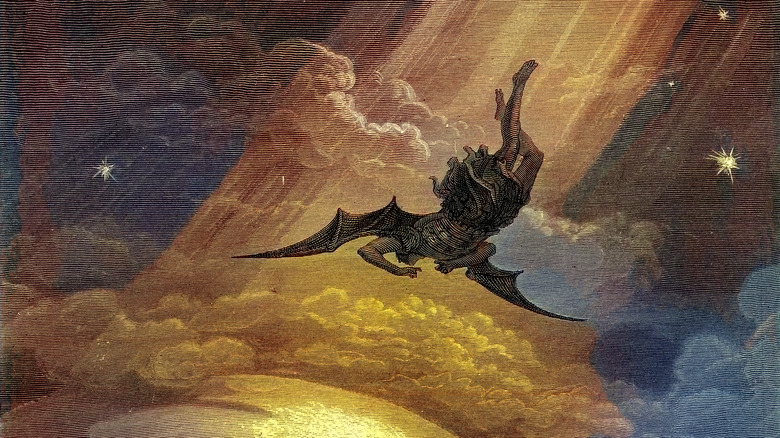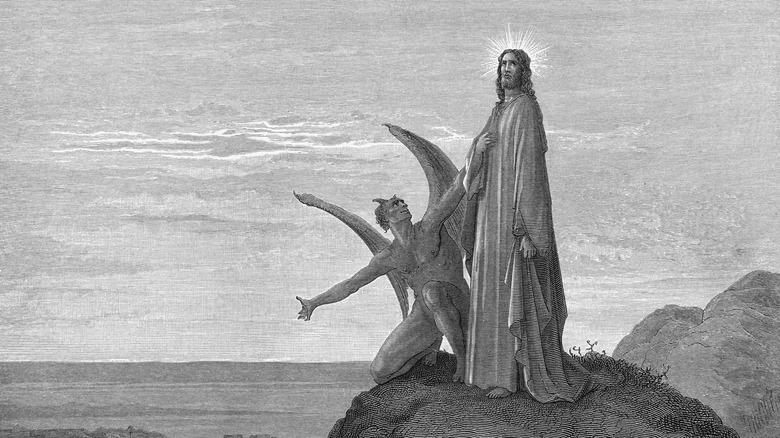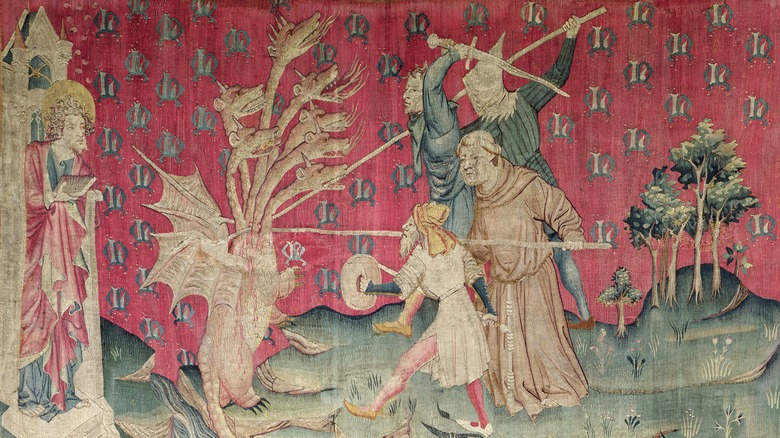What The Bible Says The Devil Really Looked Like
To most people of the Western world — religious or not — the figure of the devil, also known as Lucifer or Satan, is an early identifiable archetype. Originally described in the Bible, the precise origin of the devil has a richly interesting secret history. The figure is also featured in a great deal of Western culture, such as John Milton's "Paradise Lost" and Johann Wolfgang von Goethe's "Faust." The latter's portrayal of the devil, Mephistopheles, has shaped the character's image as a slick but vengeful trickster. Modern renderings in movies like "The Devil's Advocate" build upon these portrayals. Nevertheless, when it comes to popular culture, the devil is often cartoonish: A red-cloaked magician with horns and a pitchfork who appears in a puff of smoke, fitting in seamlessly with other ghouls and goblins at Halloween.
In the Bible, it is said that the devil was the archangel Lucifer, who suffered a fall and was banished from heaven after rebelling against God. In his exile, he came to rule over hell, where he dedicated himself to the task of deceiving and corrupting human souls, preventing them from entering the Kingdom of Heaven. And while descriptions of the devil are few and far between, they differ noticeably from those we have grown familiar with today.
The Devil in disguise
In Christianity, the Gospel of Matthew claims that the devil appeared before Jesus Christ during his 40 days and 40 nights in the desert. As the story goes, the Holy Ghost led him there to prepare for his ministry. The devil is said to have tempted Jesus three times, though he held-fast to his faith, after which the devil left him.
The incident mirrors the Fall of Man, in which a serpent in the Garden of Eden tempts Adam and Eve to eat from the forbidden Tree of Knowledge. Though the Book of Genesis does not explicitly state that the serpent in the Garden of Eden is the devil, later theologians have made the connection. It is common for believers to state that the first humans were tempted by Satan, who had taken the form of a serpent.
The Bible is often vague as to the devil's physical appearance. In Ezekiel, he is described as beautiful, though that was during his time as an archangel, prior to his rebellion. But characterization of the devil as a shapeshifter and deceiver has a strong Biblical basis. Corinthians suggests that he no longer resembled the archangel he once was but still has the ability to disguise himself as an "angel of light" to trick humans into following him.
The Devil's terrifying form in the Book of Revelation
The traditional appearance of the devil with horns and a pitchfork is believed to have derived from various medieval artworks, which were inspired by non-Biblical imagery. The Pagan god Pan, for example, was depicted as a satyr, half-goat creature of the forest who denoted fertility and the natural world. With early Christians attempting to associate Paganism with evil, the conflation makes sense, though other goat-like demons also exist in early Jewish scripture.
The devil is only described once in mammalian terms in the Bible. In the Christian Gospel of Peter, it is claimed that "the devil prowls around like a roaring lion, seeking someone to devour." However, some argue the passage is simply a simile. The same cannot be said for the terrifying Book of Revelation, the final book of the New Testament that outlines the events of the apocalypse. Describing the final battle between heaven and hell and the rebirth of heaven and Earth, the book describes an "enormous red dragon with seven heads and ten horns and seven crowns on its heads. The creature attacks heaven and Mark, the woman who is to be the mother of the Second Coming.
Here, the New Testament is transparent as to who the terrifying beast is, stating a few lines later: "Then war broke out in heaven. Michael and his angels fought against the dragon, and the dragon and his angels fought back. But he was not strong enough, and they lost their place in heaven. The great dragon was hurled down — that ancient serpent called the devil, or Satan, who leads the whole world astray. He was hurled to the earth, and his angels with him."


